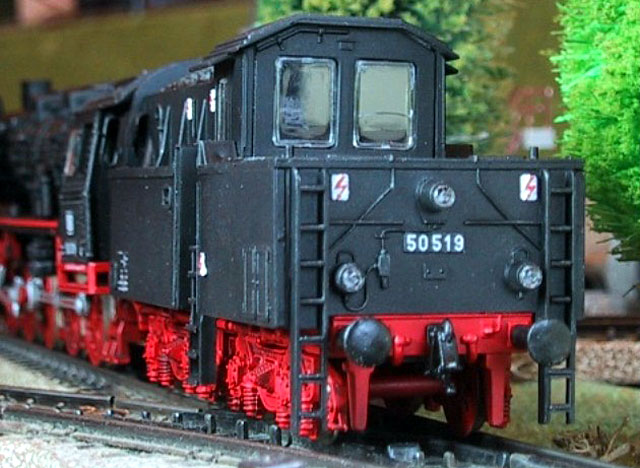|
Baureihe 50 Kab.
(Deutsche Bundesbahn)
by Bernd Korte
|
 |
|
Baureihe 50 Kab.
(Deutsche Bundesbahn) Locomotive |
images by Deun Yu

HyperScale is proudly supported by Squadron
1/87 Revell
Baureihe 50 Kab. (Deutsche Bundesbahn)
|
A steam locomotive???
To put this into a better prospective, I should start at an earlier time …
Some time ago my father bought a Revell kit of a German steam locomotive
the Br 50. Since I was working on an airplane model at that time and
didn't want to start something new before finishing it, the Revell kit got
put aside. But as both the research for a 1/72 F-102 Delta Dagger and for
an alternative project (Gloster Meteor NF 11) didn't progress the way I
had planned ... I remembered my father's kit.
The "Baureihe 50"
literally translated "Series 50"
The Baureihe 50 was
developed and built before WWII when the German railway was still called "Reichsbahn".
Due to its low axle load, the 50 proved to be exceptionally suitable for
operating on the numerous side-tracks. Thus by 1943, 3164 engines had
already been built.
After the war the surviving
locomotives stayed in service with the two new German railroad companies
("Deutsche Bahn" in Western Germany and "Reichsbahn" in Eastern Germany
the DDR) with 2159 being with the "Deutsche Bahn".
At the beginning of the
1960's, 751 tenders were equipped with the so-called conductor cabs (Br 50
Kab.) This made the locomotive even more practical and multi-purpose. Only
the coal supply was reduced by the new space requirements of the new cab
from 8 t to 6.6 t.
A Br 50 with a converted
tender was built from the Revell kit. Other than the transparent parts for
the windows, all 143 plastic parts are molded in black.

To complete the kit there
is a track the length of the locomotive on which the finished model can be
presented and a small decal-sheet with the serial numbers etc.
Construction
Construction is
straightforward per the instructions. Only a few parts have flash that
require removal. Choosing the colors, I just followed the instructions as
even Revell could hardly go wrong with the colors used on a German steam
locomotive (black and red). The complete framework of the locomotive,
tender and the wheels are painted in red: Revell # 330. The boiler, the
control cabin, tender and the cylinders are airbrushed in black: Revell #
302. As all these components can be built and painted separately there
isn't much to mask. Painting the coupling red and silver does take
somewhat a little more time.

After all components had been finished separately including decaling and
weathering, it was just a matter of assembly. At this point I installed
the clear parts through the not-fixed roof.
The only fitting problem was encountered when building the tender. The
rear wall (part 10 B) was at both sides too short. I had to insert a small
plastic sheet to fill the gaps between the side walls and rear wall.
Weathering was done by drybrushing in silver/ iron and washing the chassis
of the locomotive and tender with black diluted oil paint. After that,
these areas were sealed with "Erdal Glänzer" (the German "Future"). After
applying the few decals I sealed the model with a final coat of silk-matte
Humbrol lacquer except the coals. The coals do not get this finish as to
keep them contrasting with the tender.
The relatively short
construction period of three weeks (with breaks), I would recommend this
kit as a nice "time out" project. But be sure, the F-102A is now back on
my assembling line. Nevertheless, I wouldn't mind again building another
railway kit in the future for a change of pace.

Special thanks to R L Donaldson who helped me with this translation
(original German article can be seen at
www.modellversium.de in the
gallery).
Click the
thumbnails below to view larger images:
Model and Text Copyright ©
2003 by Bernde Korte
Images Copyright © 2003 by Deun Yu
Page Created 30 July, 2003
Last Updated
17 March, 2004
Back to
HyperScale Main Page |
Home |
What's New |
Features |
Gallery |
Reviews |
Reference |
Forum |
Search